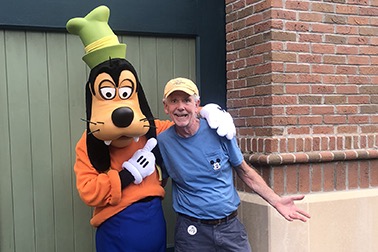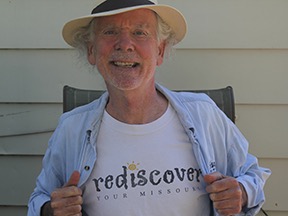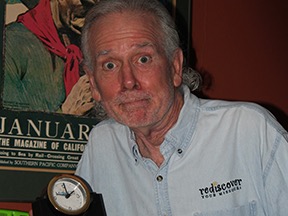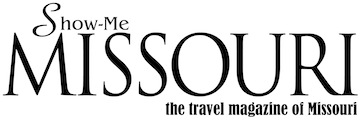Your Inner Mouseketeer
November 2021
 by JOHN ROBINSON
by JOHN ROBINSONCould a tiny Midwest town founded with little fanfare by the Santa Fe Railroad have a main street that competes with the bright lights of Broadway, the music on Bourbon Street, the stars along Hollywood Boulevard?
Perhaps the most replicated street in the world runs through the middle of Marceline.
It’s nearly impossible to travel more than one block in Marceline without opening a page in the storybook of young Walt Disney’s life. The icons pop up everywhere, testament to Walt’s influence on the town, and the town’s influence on Walt.
Flash back to 1955: Walt Disney had long since moved away from Marceline and made his mouse tracks in the world. But a half century hadn’t dulled Disney’s memories of the happiest time of his life. That’s why Marceline’s main street inspired Walt’s blueprint for Main Street USA at Disneyland. For sure, the Magic Kingdom’s Main Street was a communal effort among Walt and his art directors, who jazzed it up with bells and whistles and walking photo-ops with life-size cartoon characters. But every element of Disney’s Marceline is represented at the theme parks. The train station. The locomotive. The gazebo. The picture show.
Walt described the essence of his Main Street vision: “Main Street is everyone’s hometown–the heart line of America. To tell the truth, more things of importance happened to me in Marceline than have happened since, or are likely to in the future.”
Marceline is where young Walt first discovered the world. When he wasn’t hanging out downtown in a vacant lot beside a giant wall painted with a Coca-Cola logo, he might be found in his back yard engaged in what he later called “belly botany.” Lying on his stomach in a field, he’d conduct an up-close study of ants and aphids, crickets and critters. Indeed, the descendants of Jiminy Cricket still live here.
Kaye Malins is a walking encyclopedia on Walt’s Marceline years. She literally dreams Disney, living in his boyhood home on the outskirts of town. His home is a Disney tale in itself. Kaye has taken steps to enhance living history at Walt’s boyhood home. The bedroom Walt and brother Roy shared remains unchanged from their childhood.
Behind the house sits the barn.
In typical Disney style, the townspeople raised a new barn in 2001 to replicate the structure where 8-year-old Walt got his showbiz start. It’s a faithful replica, with a swayback roof—like the one Mouseketeers remember on TV—a shrine on the spot where his imagination began.
From all over the world, pilgrims visit the new barn, scribbling thousands of notes, verses, and signatures in every language on the rough-hewn wood walls.
Somewhere, a belly botanist is beaming.
Follow John’s travels at JohnDrakeRobinson.com/blog.
John's Taco Tour
August 2021
Rediscover
May 2021

American travel has been rocked by a cataclysm. For months our highways, airways, resorts and restaurants have reeled from the effects of the attack.
The tragic events of 9/11 changed the world forever.
It was a gut punch every American took personally. The staggering loss of life. The feeling that our open society—our ability to move freely—had been deeply wounded. In the immediate aftermath of the attack on the World Trade Center, Americans changed basic habits. They stayed closer to home, closer to family. Travel and tourism became casualties. For months people were afraid to fly...until airfares dropped to $25. Then a few people found it safe to fly again. Sometimes price plays an irrational role in rational decision making.
The day after the attack, I joined a conference call with Missouri Division of Tourism officials. We began weighing options to promote travel to Missouri in this new environment of fear. I saw a fundamental problem: In the world before 9/11, Missouri’s tourism division focused almost entirely on attracting out-of-state visitors. It always made sense. Use the ample state budget to advertise effectively in those markets forming a ring around the Show-Me State. Wichita and Topeka. Omaha. Des Moines and the Quad Cities. Springfield and Rockford. Memphis and Nashville. Little Rock. Tulsa and Oklahoma City. It was taboo in the Missouri tourism industry for the state to advertise to Missourians. Let the local attractions take care of that. But in this new environment of fear, people were staying very close to home.
On the conference call, I challenged the old taboo. “I always thought dollars from Missouri residents spend as well in Marceline, Missouri as they spend in Orlando or Anaheim.” As chief of staff to then-Lt. Governor Joe Maxwell, who chaired the Missouri Tourism Commission at the time, I proposed we break the taboo and promote Missouri to Missourians.
The result? From the ashes of this tragedy, Rediscover Your Missouri was born. Urging Missourians to “check out your own back yard,” the state promoted attractions big and small to our own residents. Museums and amusement parks. Sporting events and memorable food. Caves and fishing and floating and trendy resorts. Oh, and we promoted Missouri State Parks and conservation areas, which were prohibited from advertising their own sites.
The campaign was a record-setting success. Missouri families made great memories. They felt safer, closer to home. And hopefully many Missouri attractions got back on their feet a little faster.
With time and distance from 9/11, people began traveling more and more, farther and farther. Of course, security parameters changed. But the heightened security, if not perfect, offered some comfort to travelers.
Fast forward twenty years. Another calamity took the wind out of our travel sails. This time it was a different threat, a worldwide pandemic. But it had the same result: tourism dried up.
A long dark year has passed. But the signs are encouraging. As we slowly move back to a new normal, it might be worth a mention to our great Missouri family: Check out your own back yard.
And to those readers who live far away, we’ll keep a welcome mask on.
John’s new book, “Souls Along The Road”, caroms through Missouri destinations, forgotten history, remarkable people and memorable food. You can read more about his travels at JohnDrakeRobinson.com.
Time Skips A Beat
February 2021

If Missouri lawmakers have their way, you’ll never get it back. The “Daylight Saving as the New Standard Time Pact” is coming to several states near you. And odds are better than ever the momentum will sweep into Missouri.
The umbrella statement of the pact explains what will trigger the change: “In the year in which at least 20 states have passed legislation entering those states into the pact, each state will switch clocks to daylight saving for the last time and daylight saving time will be eliminated.”
So far in the past year, it appears we’re nearing—or already past—that 20-state trigger threshold. If Missouri joins, we’ll agree to kill the hour. Permanently.
So here we go.
Will we adjust? Summer won’t be a problem. Missouri has been springing forward since we first moved to Daylight Saving Time on April 26, 1970. Missourians younger than 50 have known nothing but the ritual “spring forward, fall back.”
I asked my granddaughters what they thought about the permanent change. They’re ok with it. “We like playing outside later in the daylight.” But honestly, they’re more interested in the legislative proposal to make the corn dog the official food of the Missouri State Fair. And they debated one legislator’s idea to name the Gateway Arch the official state monument.
“My favorite monument is George Washington Carver,” one child protested. “It has classrooms where you can do science experiments.” I agree with her, for a multitude of reasons. But I didn’t have the heart to tell her that visitors to the Arch outnumber Carver monument visitors 100 to one, a ratio not likely to change.
I wonder what George Carver—America’s foremost recycler—would think about throwing away one whole hour, and not recycle it in October.
Alas, the only constant is change.
Like a chameleon, our culture changes to suit the seasons, natural and artificial. In a short string of generations our telephones evolved from live operators to party lines to busy signals to answering machines to selfie sticks to texting while driving.
Media has exploded from three television networks to ten thousand channels, from AM to FM to satellites, from MTV to YouTube, from the smell of fresh ink in the local morning newspaper to the personalized silos of social media. Our shopping has shifted from Norman Rockwell images of downtown to giant megamalls. Now the megamalls have become struggling monuments to the shopping trip, replaced by the homey convenience and instant gratification of online shopping, next day package delivery and porch pirates. Our fingers have migrated away from the Yellow Pages and the Sears catalog to Google and Amazon Prime.
Everything evolves over time. Now time itself will evolve.
With pain, most of us have adjusted to pandemic avoidance techniques. The food delivery industry has changed our eating habits, and kept some restaurants alive while others wither and disappear. We’ve moved from drive-in theaters to indoor air-conditioned big screens and back to drive-ins.
We survived an insurrection. So I guess we’ll adjust to permanent daylight saving time. But on that Saturday night in late October, I will miss the comforting reminder, “don’t forget to set your clocks back one hour.”
Okay, fine. Take away my precious extra hour of sleep in October. But who’s gonna remind me to change the batteries in my smoke alarm?
John kills time by writing in JohnDrakeRobinson.com.
